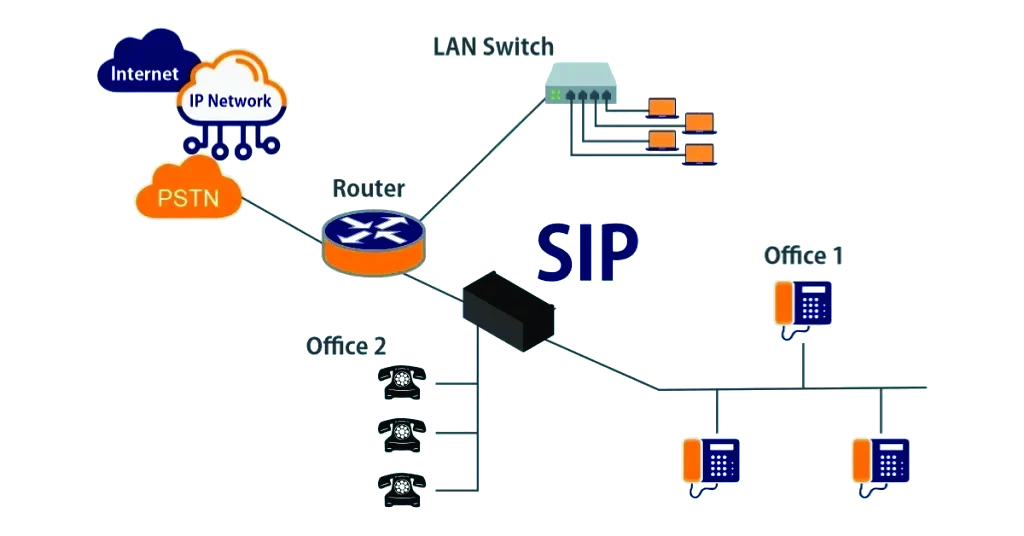Managing communication platforms is becoming increasingly complex for businesses, leading to missed opportunities, disconnected processes, and rising operational costs. Unified Communications (UC) provides an integrated approach to streamline business interactions and enhance collaboration, addressing the evolving needs of modern organizations. From omnichannel contact centers to SIP trunk providers, the future of unified communications is about more innovative tools and seamless connectivity.
Let’s explore the key trends driving this transformation and how businesses can leverage them for long-term success.
- AI-Driven Unified Communication: Smarter, Faster, Better
Artificial intelligence (AI) transforms unified communications, offering capabilities like intelligent call routing, real-time transcription, and sentiment analysis. AI enables businesses to automate routine processes and provide personalized customer interactions.
For example, a hospitality company using AI-powered Chatbots can respond to customer inquiries instantly, even during peak hours. This reduces the workload on human agents and ensures consistent service. As AI evolves, expect even more seamless interactions, such as predictive responses based on customer behavior, helping businesses stay one step ahead in delivering value.
- Omni-Channel Contact Centres: Meeting Customers Where They Are
Today’s customers expect seamless experiences across multiple touchpoints—social media, email, phone calls, and live chat. Omni-channel contact centers unify these channels into a single platform, offering businesses a holistic view of customer interactions and enabling real-time responses.
Imagine a retailer receiving customer inquiries across Instagram, email, and phone. With an omnichannel contact center, each conversation is tracked and managed in one place, ensuring smooth communication and building customer trust. This holistic approach not only improves efficiency but also fosters brand loyalty.
- SIP Trunk Providers: Flexibility and Cost Efficiency
The days of maintaining expensive phone lines are behind us. SIP trunk providers shift communications to the cloud, allowing businesses to scale their operations without infrastructure burdens. This flexibility will enable companies to expand communication lines during peak seasons and scale back when necessary.
Airports are a prime example. During busy holidays, they can activate additional communication lines to manage passenger queries. Once the peak season ends, they scale back, paying only for the services they use. This scalable model optimizes operations and reduces communication costs.
- Cloud-Based Communication: Adaptable and Resilient
Cloud-based solutions are at the heart of unified communications, allowing businesses to adapt to changing environments without being tied to legacy systems. These platforms integrate seamlessly with tools like CRMs and collaboration software, ensuring smooth workflows across departments.
Cloud platforms also support hybrid and remote work environments, allowing employees to access communication tools from anywhere. In addition to scalability, cloud-based UC offers enhanced security features like data encryption and disaster recovery options, ensuring business continuity during disruptions.
- Mobile-First Strategies: Work Anywhere, Anytime
With remote work becoming the norm, businesses adopt mobile-first communication strategies to ensure their teams stay connected and productive. Unified communication platforms optimized for mobile allow employees to manage calls, messages, and emails on the go, ensuring seamless collaboration from any location.
Imagine a sales executive closing a deal during their commute or a customer service agent resolving a query remotely through their smartphone. Keeping connected always improves productivity and ensures no business opportunities are missed.
- Enhanced Collaboration with Unified Messaging
Effective collaboration relies on streamlined communication channels. Unified messaging consolidates emails, SMS, voice calls, and instant messaging into a single platform, making it easier for teams to work together. Employees can start a conversation via chat, switch to a voice call, and follow up with an email, all within the same system.
This fluidity reduces communication gaps and ensures everyone stays on the same page. It also enables better data tracking, helping businesses identify patterns, streamline processes, and make data-driven decisions.
- Cybersecurity: Protecting Sensitive Communication
As businesses adopt advanced communication technologies, ensuring robust security becomes critical. UC platforms integrate multi-factor authentication, end-to-end encryption, and AI-driven threat detection to safeguard sensitive information.
For instance, a financial institution using unified communication platforms must secure customer data during interactions. With advanced security measures, businesses can ensure compliance with regulations and protect against data breaches, building customer trust.
- Virtual and Augmented Reality in Communication
Virtual Reality (VR) and Augmented Reality (AR) redefine how businesses communicate and collaborate. Imagine virtual meeting rooms where remote teams feel like they are physically together or AR-enhanced customer support that provides real-time visual guidance. These immersive technologies enhance interaction and will become increasingly integrated into unified communications platforms, particularly in industries like education, healthcare, and manufacturing.
- Personalization in Unified Communications
Personalized communication tools are becoming essential, allowing businesses to tailor their platforms to individual needs. Employees can customize interfaces and workflows, improving productivity and user satisfaction. This trend ensures communication systems align with personal preferences and business objectives, enhancing engagement and efficiency.
- Unified Communications as a Service (UCaaS)
UCaaS offers a scalable solution for businesses seeking flexibility without heavy infrastructure investments. Delivered over the internet, UCaaS provides essential communication tools—such as messaging, video conferencing, and voice services—through subscription models. This trend allows businesses to scale their operations efficiently, supporting remote and hybrid work environments.
- Integration with the Internet of Things (IoT)
The Internet of Things (IoT) transforms unified communications by providing real-time data for more intelligent business operations. Connected devices enable automated workflows, such as bright meeting rooms that adjust settings based on occupancy or sensors that notify managers of required equipment maintenance. This trend fosters a more responsive and productive environment, enhancing the overall communication experience.
Embrace the Future of Unified Communications with Telerain
The future of unified communications is about more than connecting people—it’s about creating a dynamic and responsive communication environment. As businesses adopt omnichannel contact centers and SIP trunk providers, staying ahead of trends is essential to remaining competitive.
At Telerain, we offer integrated communication solutions tailored to your needs. From cloud-based UC platforms to seamless mobile integration, we ensure your business stays connected, efficient, and secure.
Let’s show you how we can transform your communication strategy.
Contact us today to build the future of business communication.
About The Author: Telerain, your trusted partner in streamlined digital business communication solutions. Our integrated cloud software service combines a comprehensive suite of channels, including voice, SMS, fax, video, chat, and email, ensuring your business stays connected most efficiently and securely.
At Telerain, we prioritize the security and compliance of your communications. Our platform automatically addresses GDPR, PCI DSS, and HIPAA regulations, guaranteeing that all interactions are recorded and archived compliantly. It means you can focus on your business, confident that your communications meet the highest data protection and privacy standards.
Our user-friendly per-user-per-month Software as a Service (SaaS) model ensures flexibility without the burden of legacy technology costs and complexities.





